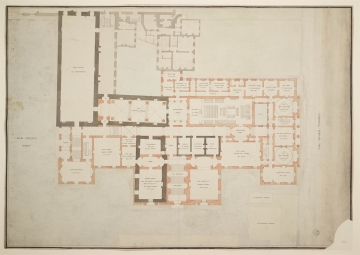Scale
(36) to a scale of 1/7 inch to 1 foot (37) to a scale of 1/15 inch to 1 foot
Inscribed
(36) The Plan of a Design to render the House of Lords and the Rooms and Offices appertaining thereto more commodious. A, labelled: Old Palace Yard, The River Thames, Mr Delaval's Offices, rooms labelled: The Vestibule, Arcade, The Lords / Robing Room, Officers of / the Lord / Great Chamberlain, The Lord / Great Chamberlain, Robing Room / for the Prince of Wales / and the rest of the / the Royal Family, His Majesty's / Entrance, His Majesty's / Robing Room, Council / attending / the House, Witnesses / attending / the House, Clerk of / Committees, The Great Committee Room, Committee Room, The / Earl Marshall, The Lord Chancellor / and Judges, Attendants / on the Lord Chancellor, The Court / of Parliament, The / Painted Chamber, The House / of Lords, Court, The / Lord Chancellor, the Clerk / of Parliament, Writing Clerk, Assistant Clerk / of Parliament, The Bishops / Robing Room, Archbishops / Robing Room, Messengers with Bills / from the House / of Commons, Black Rod, Black Rod together with doorkeepers' lobbies, lobby, closets and water closets, some dimensions given
(37) labelled Old Palace Yard, The River Thames, Mr Delaval's House, Mr Delaval's Offices, rooms labelled as drawing 36 and some dimensions given
Medium and dimensions
(36) Pen, sepia, red, blue and green washes, pricked for transfer on laid paper, two sheets joined, one old repair (750 x 1220, flier 483 x 268) (37) pen, sepia, red, blue and green washes with quadruple-ruled and black wash border, pricked for transfer on laid paper, right-hand bottom corner repaired (505 x 721)
Hand
(36, 37) Frederick Meyer (1775-?, pupil April 1791 - 1796)
Watermark
(36) J Whatman 1794 (37) Edmeads & Pine 1794
Notes
Drawings 36 and 37 share the same design and are drawn to a format that differs from previous plans. Instead of the sheet being used portrait-wise (that is, the short sides at top and bottom), the plan is placed laterally across the sheet (with the short sides right and left). This is because the principal entrance is now on the southward side of the building and not as previously (except for drawings 6-8) towards the west. The flier of drawing 36 offers an alternative treatment for the front facing the river so that it has a recessed centre with seven windows and six columns instead of the four-column recessed centre with three windows flanked by twin one-window projections flanked each side by a single column. The royal progress begins with an entrance with a wide passageway with three flights of steps, a right turn into an oval lobby, another right turn into the King's Robing Room, from here a return to the oval lobby and through the 'Great Committee Room' into another lobby and thence the House of Lords. The offices for the various functionaries are laid out in a single file on the north and and east sides of the building. The impression is of a more thorough revision of the design led by the re-positioning of the King's Entrance.
A comparison of plans with elevations suggests that the southward (flank) 15-bay elevations 72 and 77 may relate to (plans) 36 to 46 though not as regards columniation.
S.Sawyer, 'Soane at Westminster', PhD thesis, Columbia University, 1999, p. 180. The final design (a 'synthesis of two planning approaches' taken from 'A1' to 'A6') includes drawings 36 and 37. Reference also to drawings 37, pp. 181, 182.
Level
Drawing
Digitisation of the Drawings Collection has been made possible through the generosity of the Leon Levy Foundation





